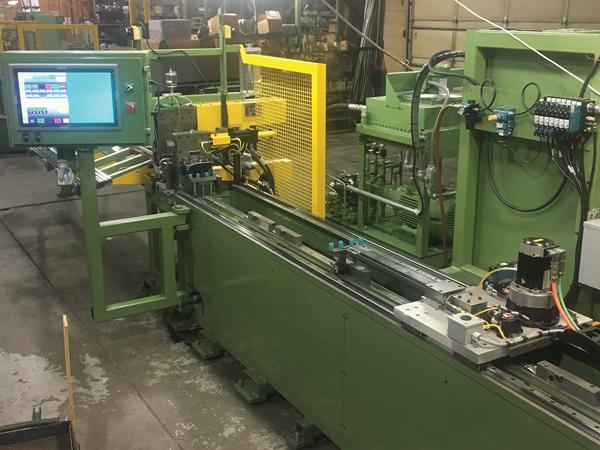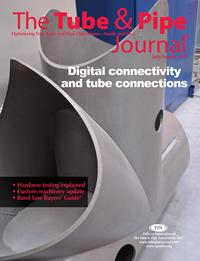- FMA
- The Fabricator
- FABTECH
- Canadian Metalworking
Categories
- Additive Manufacturing
- Aluminum Welding
- Arc Welding
- Assembly and Joining
- Automation and Robotics
- Bending and Forming
- Consumables
- Cutting and Weld Prep
- Electric Vehicles
- En Español
- Finishing
- Hydroforming
- Laser Cutting
- Laser Welding
- Machining
- Manufacturing Software
- Materials Handling
- Metals/Materials
- Oxyfuel Cutting
- Plasma Cutting
- Power Tools
- Punching and Other Holemaking
- Roll Forming
- Safety
- Sawing
- Shearing
- Shop Management
- Testing and Measuring
- Tube and Pipe Fabrication
- Tube and Pipe Production
- Waterjet Cutting
Industry Directory
Webcasts
Podcasts
FAB 40
Advertise
Subscribe
Account Login
Search
Old-school machine tool builder uses a few new tricks
Custom machines outfitted with hard tooling come with the latest in electronic technology
- By Eric Lundin
- July 22, 2019
- Article
- Tube and Pipe Production
If someone in the metal fabrication industry described a tube fabrication machine equipped with a sophisticated electronic control package, an onboard diagnostic system, the latest sensor technology, automatic loading and unloading, a combination of hardware and software that allows it to change from one job to the next quickly, and remote access capability so the manufacturer could do some diagnostics and troubleshooting without visiting your facility, what would you think? You’d probably guess that the machine was one of the latest laser cutting machines or a sophisticated, mandrel-capable, multistack, left- and right-hand bending machine, wouldn’t you? These would be two possibilities, but they wouldn’t be the only possibilities. Believe it or not, this description fits some traditional metalworking machines, those that do the bulk of the work in the fabrication industry. These are hydraulically driven machines built with custom-made tooling. These are modern versions of conventional machines. Machines that rely on tried-and-true hard tooling, updated with essentially everything the modern world has to offer.
While state-of-the-art lasers and CNC benders have taken tube fabrication far in the last few decades, these represent the metaphorical tip of the technology iceberg—just a small percentage of the machines used in fabrication shops.
Small hydraulic presses have been used throughout the modern era of manufacturing to drive all sorts of tools to pierce, punch, notch, bend, form, crimp, flatten, and cut off workpieces. This is the essence of the jack-of-all-trades, the ironworker, which certainly is among the most versatile and indispensable machines in the metal fabrication industry. Hand-fed and often actuated with a foot pedal, an ironworker normally processes one workpiece at a time, although two-operator ironworkers also are available.
Imagine a machine that does many of these processes, outfitted with a hopper for automatic loading and a dispenser for unloading, actuated automatically, and you hit the sweet spot: a machine with some of the versatility of an ironworker combined with the cycle time of a dedicated production machine.
A chat with the staff at Innovo Corp., Elk Grove Village, Ill., illustrates the state of technology as it applies to this variety of machine.
Feed, Punch, Cut Off
“A metal fencepost, rail, or a leg for an industrial guarding system is a typical application for these machines,” said Ron Bochat, sales engineer for Innovo Corp, Elk Grove Village, Ill. Whether made from tubing—square or rectangular—or an extrusion or a roll-formed section, this sort of application usually calls for a series of square holes or rectangular slots along its length, and perhaps a series of piercings as well, and often an end form or a notch.
“You can make square or rectangular holes in a router, then take the part to a drill press to make the small round holes, and then go to a third station to form or notch the ends,” Bochat said, describing an inefficient process, one with too many material handling steps and, most likely, poor flow.
While a laser certainly could get the job done quickly, laser users might be surprised to learn that a machine outfitted with a hydraulically driven punching unit can beat a laser’s cycle time on many jobs.
“A custom-made machine can do all of these steps, often in a cycle time of 20 to 30 seconds, and often less,” Bochat said.
Nobody, including Bochat, doubts that laser machines have a well-defined and growing share of the fabrication market, but for speed, accuracy, and capital investment, a system that uses hard tooling is a viable contender.
Straight parts are the fastest and easiest, but this sort of machine’s potential to do complex processes is limited only by the imagination of the machine builder.
“We got a contract to build equipment to make a tubular safety restraint component,” Bochat said. Bent on a dedicated bender, the finished tube resembles an incomplete letter D, has an end form, and along the straight section has a complex notch.
“A competing part had a burr on the ID of the notch, which isn’t allowed,” he said. “Our process forms the notch from the inside of the tube. It still creates a small burr, but it’s on the OD, where it doesn’t interfere with the restraint system’s function,” he said.
While CNC tube benders are the mainstay for complex bends, especially compound and variable-radius bends, a dedicated bender is a practical alternative for a dedicated system.
Built for Expansion
The essence of the company’s work is versatility. While it’s true a programmable machine with a cutting head that moves on several axes—that is, a laser—is the pinnacle of flexibility, a well-designed custom machine is immensely adaptable.
“We try not to build machines that make just one series of parts,” Bochat said. “When we work through an inquiry, we always ask, ‘What else do you make? What else can we help with?’” It sounds like a paradox, but the company’s owners know that building the fewest machines possible is the key to its health and longevity. Building a few very capable machines will serve its customers much better than building a large number of one-trick ponies.
What happens when a customer doesn’t say too much about its other projects? A little intuition and a long look around at the customer’s shop can go a long way.
“We often build machines that are ready for expansion and modification,” said Adam Szczepaniec, electrical engineer and one of Innovo’s three owners. Often the company’s engineering staff optimizes a frame concept for the intended application, providing enough clearance so maintenance is easy and tooling changeovers go quickly. From there, the staff often revises the frame’s design, opening it up a bit, providing some extra space and maybe some additional reinforcement. This gives the machine room to grow and provides more strength to accommodate more functions in the future.
“We can always bring a machine back to the shop and rebuild it, but it makes more sense to build the machine so it’s ready for expansion,” said Szczepaniec. The machine still has to come back to the company for updating, but then it’s just a matter of retrofitting by adding another module to it.
Tolerating Greater Tolerances
Looking beyond the fabrication tasks at hand, the company’s engineering staff also takes into account the dimensions and tolerances of the raw material.
“Keeping a hole location within a few thousandths of an inch isn’t hard when the tube is straight, but if the tube has camber or twist, that’s a different ballgame,” Szczepaniec said. To be really accurate, the control system takes into account the ambient temperature. A shop temperature that varies from 60 degrees F to 105 degrees F, which isn’t unheard of, can lead to inaccuracies in cut lengths and hole locations. Across this temperature range, a 20-foot carbon steel tube can grow by 1⁄16 inch. That doesn’t sound like much, but it depends on the industry. On a fencepost, nobody would even notice a hole or a slot off by 0.0625 in. However, in other industries, notably auto and especially aerospace, a difference of 0.0625 in. is sloppy work.
Even without considering the temperature coefficient, the Innovo staff has to consider the variety of tube quality available in the market.
“We build equipment based on tube’s dimensions and tolerances supplied by the customer, not tolerances cited in a commercial specification,” Szczepaniec said. All of the dimensions are crucial in building a system that achieves short cycle times and delivers high-quality parts, but the ID is the most critical in operations that use an arbor to support the tube. Dimensional inconsistencies can wreak havoc on a process that uses a tight-fitting arbor.
“If the customer buys raw material that varies too much, we can always take the arbor down a few thousandths of an inch, but the tradeoff is a sacrifice in quality,” Bochat said.
Innovations
Even regarding a conventional, inexpensive notching die for the fencing industry, a tool that works on a single tubing diameter, Innovo expanded its capability by adding two more die openings to handle two more common post diameters. It wasn’t a feat of technological mastery, and it’s not even a big revenue opportunity for the company—it’s a low-cost item, and other companies have a bigger footprint in that end of the fencing market, Bochat said—but it demonstrates the company’s willingness to rethink a traditional concept to bring something new to the market.
“We look at combining operations whenever we can,” Bochat said.
Whether a tooling set works in a single stroke, a reciprocating action, the eccentric action of a cam, or uses the force multiplier of a toggle system, the goal of a seasoned tool- and diemaker is to combine operations when possible. Whether the operations are combined in a single tool-and-die set or carried out as a progressive series of steps, the goal is to develop an elegant solution.
Likewise, the entire machine should lend itself well to the operator’s control and regular maintenance.
“A machine should be intuitive,” Szczepaniec said. “A well-designed machine is easy for the operator to use.”
About the Author

Eric Lundin
2135 Point Blvd
Elgin, IL 60123
815-227-8262
Eric Lundin worked on The Tube & Pipe Journal from 2000 to 2022.
About the Publication
Related Companies
subscribe now

The Tube and Pipe Journal became the first magazine dedicated to serving the metal tube and pipe industry in 1990. Today, it remains the only North American publication devoted to this industry, and it has become the most trusted source of information for tube and pipe professionals.
start your free subscription- Stay connected from anywhere

Easily access valuable industry resources now with full access to the digital edition of The Fabricator.

Easily access valuable industry resources now with full access to the digital edition of The Welder.

Easily access valuable industry resources now with full access to the digital edition of The Tube and Pipe Journal.
- Podcasting
- Podcast:
- The Fabricator Podcast
- Published:
- 04/16/2024
- Running Time:
- 63:29
In this episode of The Fabricator Podcast, Caleb Chamberlain, co-founder and CEO of OSH Cut, discusses his company’s...
- Trending Articles
Zekelman Industries to invest $120 million in Arkansas expansion

3D laser tube cutting system available in 3, 4, or 5 kW

Corrosion-inhibiting coating can be peeled off after use

Brushless copper tubing cutter adjusts to ODs up to 2-1/8 in.

HGG Profiling Equipment names area sales manager

- Industry Events
16th Annual Safety Conference
- April 30 - May 1, 2024
- Elgin,
Pipe and Tube Conference
- May 21 - 22, 2024
- Omaha, NE
World-Class Roll Forming Workshop
- June 5 - 6, 2024
- Louisville, KY
Advanced Laser Application Workshop
- June 25 - 27, 2024
- Novi, MI



























